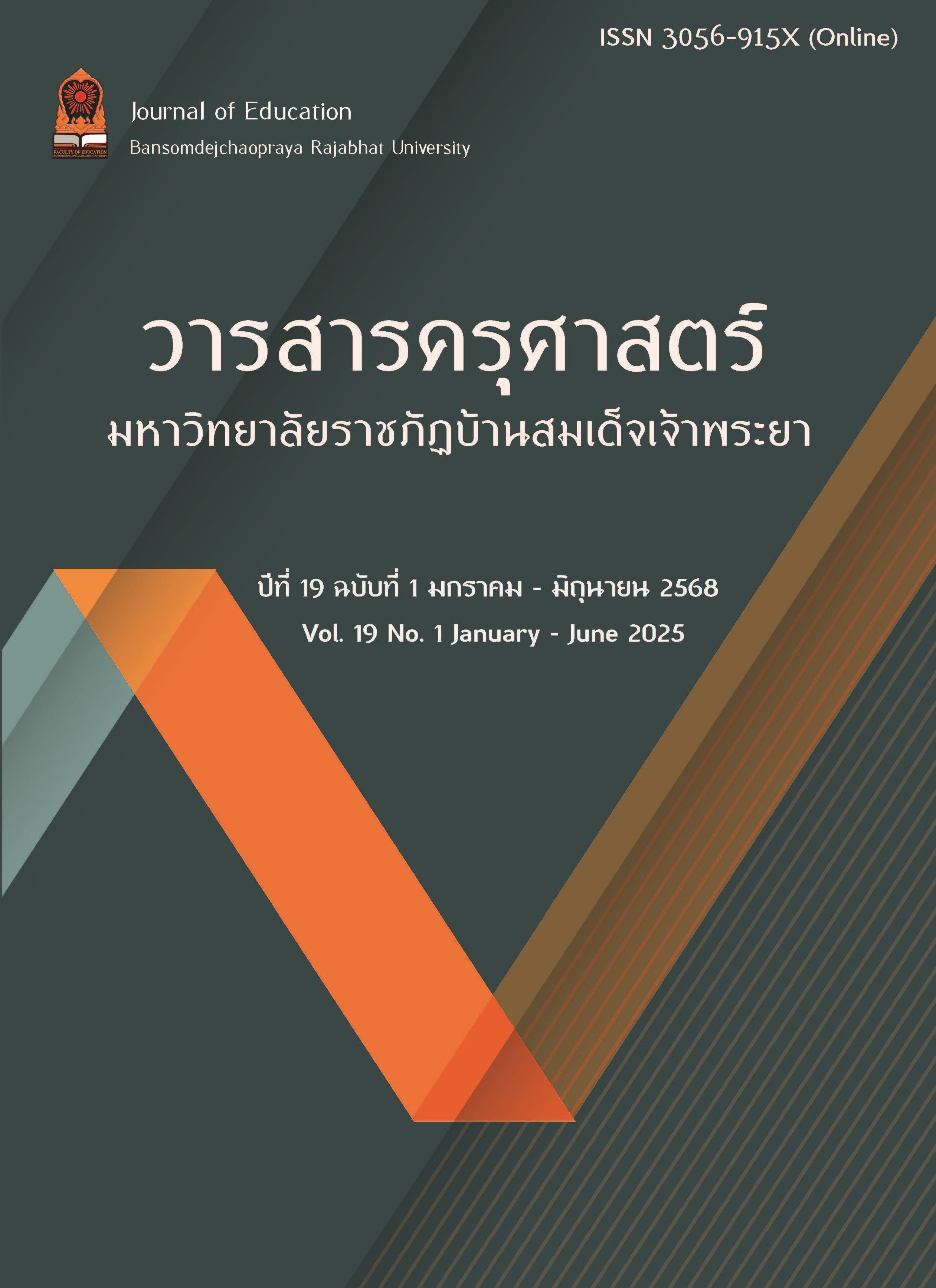A study on the necessary requirements for the development of an instructional model based on the concept of games-based learning to promote problem-solving abilities and happiness in learning among elementary school students
Keywords:
instructional model based on the concept of games-based learning, promoting enjoyable learning components, problem-solving skillsAbstract
The purpose of this research is to 1) study and analyze basic information, principles, concepts, theories and research related to the development of an instructional model based on the concept of games-based learning 2) To study opinions about the problem and needs to the development of an instructional model to promote problem-solving abilities and happiness in learning among elementary school students. This is a qualitative research. The target groups are administrators, teachers, parents, and primary school students of 4 demonstration schools. A qualified person with expertise in learning management for primary school students. The research instruments were document analysis form, structured interview form, and questionnaire on students' opinions. Data were analyzed using mean, percentage, and content analysis.
The research results found that the concept used in developing the learning management model was the concept Gerlach and Ely, 1971-2014: 32; Kemp, 1985: 1-10; Arends, 2011: 7; Joyce, Weil, & Calhoun, 2015: 25-34, Thitsanakhammanee, 2016: 222 and research and development of learning management models. Learning management models consist of 6 components. Learning management characteristics based on the concept of games as a base, 5 steps, happy learning 5 components, 5 steps to demonstrate problem-solving skills From the study of students' opinions, it was found that game-based learning was the method that students wanted to use to promote happy learning and problem-solving ability the most. It must be an activity that is about a familiar story that learners can relate to their own experiences and attract their attention. It is a meaningful and interesting topic that challenges learners to motivate them to want to learn and to be able to learn happily by themselves.
Downloads
References
กรมสุขภาพจิต. (2566). รายงานการสำรวจระบาดวิทยาสุขภาพจิตของคนไทยระดับชาติ ปี พ.ศ. 2566 (หน้า 25). นนทบุรี: สำนักวิชาการสุขภาพจิต กรมสุขภาพจิต.
กระทรวงศึกษาธิการ สำนักงานคณะกรรมการการศึกษาขั้นพื้นฐาน. (2563). แนวทางการนิเทศ เพื่อพัฒนาและส่งเสริมการจัดการเรียนรู้เชิงรุก Active Learning ตามนโยบายลดเวลา เรียนเพิ่มเวลารู้. กรุงเทพฯ: โรงพิมพ์คุรุสภา.
กิ่งกาญจน์ บูรณสินวัฒนกูล. (2563). การพัฒนาสื่อการเรียนรู้บอร์ดเกมการศึกษาเพื่อส่งเสริมความสามารถการเรียนรู้ในรายวิชาพัฒนาการแบบเรียนภาษาไทยและความสุขในการเรียนรู้สำหรับนิสิตระดับปริญญาตรี (รายงานวิจัย). กรุงเทพฯ: คณะมนุษยศาสตร์ มหาวิทยาลัยศรีนครินทรวิโรฒ.
ทิศนา แขมมณี. (2559). ศาสตร์การสอน องค์ความรู้เพื่อการจัดกระบวนการเรียนรู้ที่มีประสิทธิภาพ (พิมพ์ครั้งที่ 19). กรุงเทพฯ: สำนักพิมพ์แห่งจุฬาลงกรณ์มหาวิทยาลัย
พิมพันธ์ เดชะคุปต์. (2564). การเรียนเชิงรุกแบบรวมพลังกับ PLC เพื่อการพัฒนา. กรุงเทพฯ: โรงพิมพ์แห่งจุฬาลงกรณ์มหาวิทยาลัย.
พัฒผล มารุต. (2559). การวิจัยและพัฒนานวัตกรรมหลักสูตรและการจัดการเรียนรู้. วารสารศิลปากรศึกษาศาสตร์วิจัย, 12(1), 1–16. เข้าถึงได้จาก https://so05.tcithaijo.org/index.php/ suedureasearchjournal/article/view/240286.
รัตติกาล สิทธิยศ. (2560). การพัฒนารูปแบบการเรียนรู้แบบผสมผสานสำหรับการศึกษาภาษาอังกฤษของนักเรียนชั้นมัธยมศึกษาตอนปลาย. วารสารศึกษาศาสตร์, 48(1), 45–60.
ลัดดา หวังภาษิต. (2557). การพัฒนารูปแบบการเรียนรู้ภาษาอังกฤษที่เสริมสร้างความสุขในการเรียนรู้ของนักเรียนชั้นประถมศึกษาโรงเรียนสาธิตสังกัดสำนักงานคณะกรรมการการอุดมศึกษา. (วิทยานิพนธ์การศึกษาดุษฎีบัณฑิต). กรุงเทพฯ: มหาวิทยาลัยศรีนครินทรวิโรฒ.
สถาบันทดสอบทางการศึกษาแห่งชาติ. (2566). สรุปผลการทดสอบทางการศึกษาระดับชาติขั้นพื้นฐาน (ONET) ชั้นประถมศึกษาปีที่ 6 ปีการศึกษา 2565. เข้าถึงได้จาก https://www.niets.or.th/ th/content/view/25618.
สถาบันส่งเสริมการสอนวิทยาศาสตร์และเทคโนโลยี. (2560). คู่มือครูหลักสูตรปรับปรุง 2560. กรุงเทพฯ: สถาบันส่งเสริมการสอนวิทยาศาสตร์และเทคโนโลยี.
สิริกุล กิตติมงคลชัย. (2562). การพัฒนามาตรวัดความสุขในการเรียนของนักเรียนมัธยมศึกษาตอนต้นในเขตกรุงเทพมหานคร. (วิทยานิพนธ์ครุศาสตร์มหาบัณฑิต). กรุงเทพฯ: จุฬาลงกรณ์มหาวิทยาลัย.
สุวิทย์ มูลคำ. (2551). กลยุทธ์การสอนคิดวิพากษ์ (พิมพ์ครั้งที่ 2). กรุงเทพฯ: ภาพพิมพ์.
สุวิทย์ มูลคำ และอรทัย มูลคำ. (2552). 19 วิธีจัดการเรียนรู้: เพื่อพัฒนาความรู้และทักษะ (พิมพ์ครั้งที่ 7). กรุงเทพฯ: การพิมพ์.
สำนักส่งเสริมสุขภาพ กรมอนามัย กระทรวงสาธารณสุข. (2564). การส่งเสริมสุขภาพสำหรับสมาชิกชมรมสร้างสุขภาพ. กรุงเทพฯ: (ม.ป.ท.)
วรรณภา เหล่าไพศาล. (2562). การพัฒนารูปแบบการจัดการศึกษาตามแนวทางพหุวัฒนธรรมศึกษาสำหรับนิสิตนักศึกษากลุ่มชาติพันธุ์ในสถาบันอุดมศึกษาภาคเหนือ. วารสารศึกษาศาสตร์, 44(2), 57–73.
วรัตต์ อินทสระ. (2563). Game Based Learning - The Latest Trend Education 2019 เปลี่ยนห้องเรียนเป็นห้องเล่น. กรุงเทพฯ: มหาวิทยาลัยสวนดุสิต.
วันทนา งาเนียม และพรสิริ เอี่ยมแก้ว. (2564). ผลการจัดการเรียนรู้แบบสืบเสาะหาความรู้ที่มีต่อทักษะกระบวนการทางวิทยาศาสตร์ของนักเรียนชั้นมัธยมศึกษาปีที่ 5. วารสารบัณฑิตวิจัย, 12(1), 55-67.
วิจารณ์ พานิช. (2556). การเรียนรู้เกิดขึ้นได้อย่างไร. กรุงเทพฯ: เอส.อาร์.พริ้นติ้ง.
Alessi, S. M., & Trollip, S. R. (2001). Multimedia for learning: Methods and development (3rd ed.). Allyn & Bacon.
Arends, R. J. (2011). Learning to Teach (5th ed.). Boston: McGraw-Hill.
Bloom, B. S. (Ed.). (1956). Taxonomy of educational objectives: The classification of educational goals. Handbook I: Cognitive domain. Longmans, Green.
Bostan, B. (2020, 22 April). Player motivations: A psychological perspective. Retrieved from https://www.researchgate.net/publication/220686151.
Dick, W. & Carey, L. (2021). The systematic design of instruction. Upper Saddle, River, New Jersey: Pearson Press.
Duke, R. D. (1974). Gaming: The future’s language. New York: Halsted Press.
Gerlach, V. S., & Ely, D. P. (1971). Teaching and Media: a Systematic Approach. Englewood Cliffs, N.J.: Prentice-Hall.
Guilford, J.P. (1971). The Nature of Human Intelligence. NewYork. McGraw Hill.
Helliwell, J. F., Layard, R., & Sachs, J. (2010). The world happiness report 2010. Sustainable Development Solutions Network.
Jarvinen, A. (2011). Building customer relationship through game mechanics in social games. In V. Carvalho & M.
Cruz-Cunha. (Eds.), Business, technological and social dimensions of computer games: Multidisciplinary developments (pp. 348–365). Information Science Reference.
Joyce, B. R., Weil, M., & Calhoun, E. (2015). Models of teaching (9th ed.). Boston, MA: Pearson.
Kemp, J. E. (1985). The Instructional Design Process. New York: Harper & Row.
Layard, R. (2015). Learning with Happiness. London: Cambridge University Press.
Tan, C. P., Ling, T. C., & Ting, S. H. (2011). Attitudes and motivation of Malaysian secondary students towards learning English as a second language: A case study. 3L: The Southeast Asian Journal of English Language Studies, 17(1), 40–54.
UNESCO. (2015). Education for All 2015: Global Monitoring Report (Report No. 10).
United Nations Children’s Fund (UNICEF), & Save the Children. (2013). A better way to protect all children: The theory and practice of child protection systems. UNICEF.
Weir, J. J. (1974). Problem Solving Is Everybody’s Problem. Science Teacher, 4: 16-18.
Downloads
Published
How to Cite
Issue
Section
License
Copyright (c) 2025 Faculty of Educaion Bansomdejchaopraya Rajabhat University

This work is licensed under a Creative Commons Attribution-NonCommercial-NoDerivatives 4.0 International License.
บทความที่ได้รับการตีพิมพ์เป็นลิขสิทธิ์ของคณะครุศาสตร์ มหาวิทยาลัยราชภัฏบ้านสมเด็จเจ้าพระยา
ข้อความที่ปรากฏในบทความแต่ละเรื่องในวารสารวิชาการเล่มนี้เป็นความคิดเห็นส่วนตัวของผู้เขียนแต่ละท่านไม่เกี่ยวข้องกับมหาวิทยาลัยราชภัฏบ้านสมเด็จเจ้าพระยา และคณาจารย์ท่านอื่นๆในมหาวิทยาลัยฯ แต่อย่างใด ความรับผิดชอบองค์ประกอบทั้งหมดของบทความแต่ละเรื่องเป็นของผู้เขียนแต่ละท่าน หากมีความผิดพลาดใดๆ ผู้เขียนแต่ละท่านจะรับผิดชอบบทความของตนเอง



